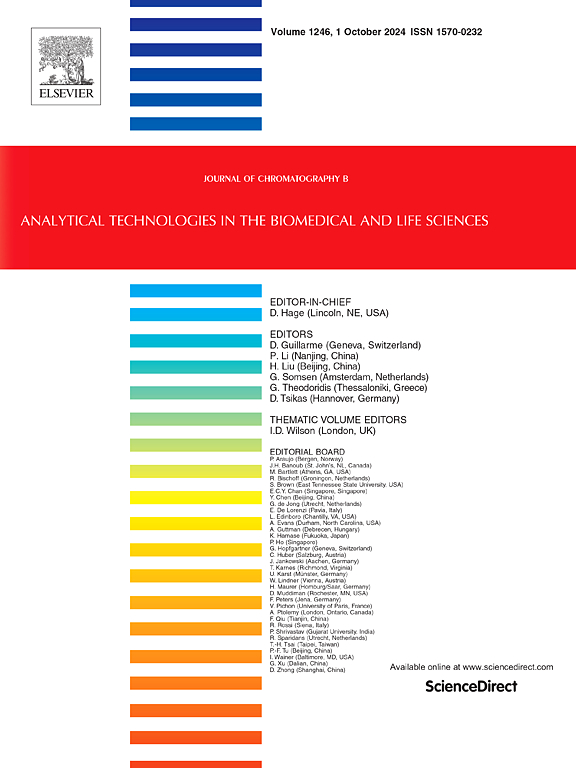高效液相色谱法纯化跨膜带3蛋白
IF 2.8
3区 医学
Q2 BIOCHEMICAL RESEARCH METHODS
引用次数: 0
摘要
带3是红细胞膜中最丰富的蛋白质,在各个研究领域受到越来越多的关注。然而,商业上可用的重组带3仅限于其细胞质域,通常在大肠杆菌中产生,因此不适合涉及跨膜区域的研究。此外,从红细胞(RBC)中纯化Band 3存在挑战,因为它与膜和细胞骨架蛋白有很强的相互作用,通常需要免疫沉淀作为获得可溶性形式的主要方法。本研究验证了从红细胞膜中纯化能带3的色谱策略。采用反相色谱法和排粒径色谱法对可溶性幽灵进行处理。使用聚丙烯酰胺凝胶进行分子量验证,并通过western blot分析确认可溶性Band 3的存在。该方法利用蛋白质的物理化学性质-特别是它们的疏水性和大小-来促进能带3的成本效益和高效纯化。本文章由计算机程序翻译,如有差异,请以英文原文为准。
High-performance liquid chromatography strategy for purifying the transmembrane band 3 protein
Band 3 is the most abundant protein in the red blood cell membrane and has garnered increasing attention across various research fields. However, commercially available recombinant Band 3 is limited to its cytoplasmic domain, typically produced in Escherichia coli, rendering it unsuitable for studies involving the transmembrane region. Furthermore, the purification of Band 3 from red blood cells (RBC) presents challenges due to its strong interactions with membrane and cytoskeletal proteins, often necessitating immunoprecipitation as the primary method to obtain it in a soluble form. This study validates a chromatographic strategy for purifying Band 3 from erythrocyte membranes. Soluble ghosts were processed using reverse-phase chromatography followed by size-exclusion chromatography. Molecular weight validation was performed using polyacrylamide gels, and the presence of soluble Band 3 was confirmed through western blot analysis. This method leverages the physicochemical properties of proteins—specifically their hydrophobicity and size—to facilitate the cost-effective and efficient purification of Band 3.
求助全文
通过发布文献求助,成功后即可免费获取论文全文。
去求助
来源期刊

Journal of Chromatography B
医学-分析化学
CiteScore
5.60
自引率
3.30%
发文量
306
审稿时长
44 days
期刊介绍:
The Journal of Chromatography B publishes papers on developments in separation science relevant to biology and biomedical research including both fundamental advances and applications. Analytical techniques which may be considered include the various facets of chromatography, electrophoresis and related methods, affinity and immunoaffinity-based methodologies, hyphenated and other multi-dimensional techniques, and microanalytical approaches. The journal also considers articles reporting developments in sample preparation, detection techniques including mass spectrometry, and data handling and analysis.
Developments related to preparative separations for the isolation and purification of components of biological systems may be published, including chromatographic and electrophoretic methods, affinity separations, field flow fractionation and other preparative approaches.
Applications to the analysis of biological systems and samples will be considered when the analytical science contains a significant element of novelty, e.g. a new approach to the separation of a compound, novel combination of analytical techniques, or significantly improved analytical performance.
 求助内容:
求助内容: 应助结果提醒方式:
应助结果提醒方式:


